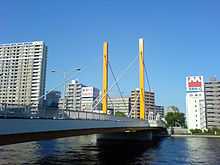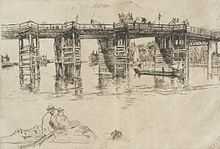Sudden Shower over Shin-Ōhashi bridge and Atake
| Japanese: 大はしあたけの夕立 Ōhashi atake no yūdachi | |
|---|---|
 | |
| Artist | Andō Hiroshige |
| Year | 9th month of 1857[1] |
| Catalogue | number 52 or 58 in the series One Hundred Famous Views of Edo |
| Type | woodblock print |
| Dimensions | approx 37 x 25 cm (prints vary) |
| Location | Edo (modern Tokyo) |
| 35°41′7″N 139°47′35″E / 35.68528°N 139.79306°E | |
Sudden Shower over Shin-Ōhashi bridge and Atake (大はしあたけの夕立 Ōhashi atake no yūdachi) is a woodblock print in the ukiyo-e genre by the Japanese artist Hiroshige. It was published in 1857 as part of the series One Hundred Famous Views of Edo.
One Hundred Famous Views of Edo
The picture is part of the series One Hundred Famous Views of Edo which actually features 119 views of 'named places' or 'celebrated spots' in the area that is today Tokyo.[2] The series was unique in being the first to feature this many separate landscape views.[3] The series was produced between 1856 and 1859 with Hiroshige II finishing the series after the death of Hiroshige in 1858. This print was published in the ninth month of 1857.[1][4] The series was commissioned shortly after the 1855 Edo earthquake and subsequent fires and featured many of the newly rebuilt or repaired buildings. The prints may have commemorated or helped draw Edo's citizens attention to the progress of the rebuilding.[5]
Description

The print shows a small part of the wooden Ōhashi (Great) bridge diagonally across the foreground of the image as the bridge crosses the Sumida River. In the background is a boatman punting his log raft, looking for shelter,[6][1] and also the far bank of the river in a part of Edo known as Atake (after the government ship, the Atakemaru that was moored there).[7] Six people are shown crossing the bridge sheltering under hats or umbrellas from a sudden shower of rain. Sudden showers are a recurring theme in ukiyo-e works and here in what Hiroshige calls "white rain"[6] are depicted using a large number of thin dark parallel lines in 2 directions - a difficult skill in woodblock printing.[4][8] At the top of the print are dark clouds from which the rain emanates. The rain, sheltering people and log raft at the centre of the image give the image a sense of movement.[6][9]
Bridges have been sited at that same location since 1694. The wooden bridge depicted in the print was replaced by another bridge in 1885, completed in 1912 and later moved to a new site elsewhere. The current bridge at the site was erected in 1973.
Influence

Hiroshige's most popular prints were produced in the tens of thousands at a low individual cost and due to the opening up of Japan after 1853 were popular both in Japan and Europe where they had a huge influence on the future Impressionist artists.[10][11] Whistler produced a number of prints and paintings using a bridge motif in London in the 1870s that were heavily influenced in their composition and subject by Hiroshige's many bridge prints. He used for example non-Western composition in the siting of the bridges, sometimes using no detailed foreground or background objects, scurrying undetailed people on the bridges, large area of negative space and the odd boat on the river.[11] The theme of scurrying people sheltering from the weather under umbrellas that is typical of One Hundred Views of Edo was an influence on Félix Buhot's Le Petit Enterrement and Hiroshige's high horizons, areas of blue wash and strong foreground imagery with lack of middle ground influenced Auguste-Louis Lepère's prints such as La Convalescente: Madame Lepère.[11]
Vincent van Gogh was a major collector of Japanese prints,[12] decorating his studio with them. He was heavily influenced by these prints, particularly Hiroshige, and made copies of two of the One Hundred Famous Views of Edo, Plum Park in Kameido and this one. He made these copies in order to try out for himself elements he admired such as the cropped composition, blocks of colour with strong outlines and diagonal elements.[13] Van Gogh's painting used brighter colours with greater contrast than the original, conspicuous brushstrokes rather than areas of flat colour, and was also framed with a selection of Van Gogh's approximations to Japanese characters.[12][13]
Hiroshige's print was listed by The Observer's art critic Laura Cumming as one of the 10 best skies in art.[14]
The composer Geoffrey Poole produced the work Crossing Ohashi Bridge for the Goldberg Ensemble and named after Hiroshige's print.[15]
References
- ↑ 1.0 1.1 1.2 Sudden Shower Over Shin-Ohashi Bridge and Atake (Ohashi Atake no Yudachi), No. 58 from One Hundred Famous Views of Edo
- ↑ Brooklyn Museum - Research: Hiroshige's One Hundread Famous Views of Edo: Famous Places of Edo
- ↑ Research: Hiroshige's One Hundread Famous Views of Edo: Famous Places of Edo
- ↑ 4.0 4.1 Sudden Shower over Shin-Ōhashi Bridge and Atake (Ōhashi Atake no yūdachi), from the series One Hundred Famous Views of Edo (Meisho Edo hyakkei)
- ↑ Good News from Hiroshige: A New Interpretation of the Series “One Hundred Famous Views of Edo”
- ↑ 6.0 6.1 6.2 'Oshashi Bridge & Atake in a suden shower'
- ↑ Ohashi bridge, evening shower in Atake
- ↑ Japanese Language Blog - Hiroshige
- ↑ Ukiyoe
- ↑ Hiroshige: Master printmaker still making waves
- ↑ 11.0 11.1 11.2 G.P. Weisberg, P.D. Cate, G. Needham, M. Eidelberg, W.R. Johnston. Japonisme - Japanese Influence on French Art 1854-1910. London: Cleveland Museum of Art, Walters Art Gallery, Robert G. Sawyers Publications. ISBN 0-910386-22-6.
- ↑ 12.0 12.1 Van Gogh and Japanese Art, Part 1 - The Bridge in the Rain (after Hiroshige) & Flowering Plum Tree (after Hiroshige)
- ↑ 13.0 13.1 Bridge in the Rain (after Hiroshige)
- ↑ The 10 best... skies in art
- ↑